Model 204 Overview and Mapping Considerations
A Model 204 file can represent one file or a collection
of files called a group. A single Model 204 file can contain records
that vary in length and format; a record can consist of fields that
also vary in length. Fields are the smallest elements or units of data.
They can occur more than once per record. A unit of records with
identical sets of fields is called a logical record type. A Model
204 file is defined in a Model 204 file description.
In the sections that follow, you will
notice that:
- A Model 204 field is equivalent to a server Master File
field.
- A logical record type corresponds to a server Master File segment.
The individual record corresponds to a segment instance.
- Model 204 fields that appear more than once in a record map
to a server Master File OCCURS segment.
- One or more record types can be described in any order in a
pair of Master and Access Files.
- One or more Model 204 files can be described in a pair of Master
and Access Files.
xFiles With One Logical Record Type
A Model 204 file that contains records with identical
sets of fields (the same logical record type) can be represented
as a single Master File segment. Each Model 204 field that occurs
only once becomes a Master File field. The ALIAS attribute in the Master
File identifies the Model 204 field name.
In the Master File, describe the logical record type as a segment.
The segment description can include some or all of the Model 204
fields in any order. The corresponding Access File identifies the
record type's Model 204 file or group name and its password; the Access
File can also include FIELD declarations that specify a TYPE attribute
to indicate the appropriate suffix operators for Model 204 key fields.
Master File field suffix operators (for example, KEY) identify different
types of Model 204 key fields.
Note: A Model 204 field that can occur more than once
should be represented as a separate OCCURS segment.
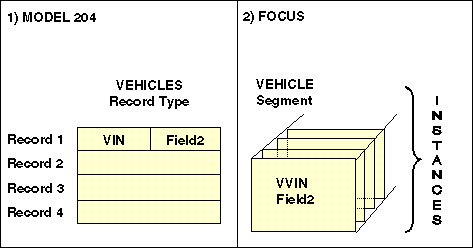
- Is one Model 204 file with one logical record type.
- Is the equivalent server Master File segment. The Master File
field VVIN represents the Model 204 field VIN.
xFiles With Multiply Occurring Fields
In Model 204 files, some fields may appear more than
once per record. Represent each multiply occurring field separately
from the non-repeating fields as a server Master File OCCURS segment.
In this case, the Master File contains a parent segment to describe
all the non-repeating fields, and a separate dependent OCCURS segment
for each multiply occurring field.
When you create a Master File, describe the OCCURS segment only
if you need the multiply occurring field for your reports. You are
not required to describe every multiply occurring field. Do not
describe the OCCURS segment in the corresponding Access File unless
its size exceeds the buffer capacity, a situation that is explained
in Customizing the Model 204 Environment.
xDescribing Files to the Server
The following diagram illustrates one multiply occurring
field and its equivalent OCCURS segment:
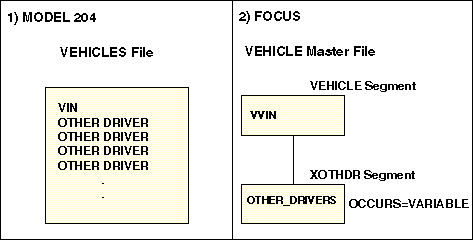
- Is the Model 204 VEHICLES file with one logical record type
and one multiply occurring field called OTHER DRIVER that identifies
drivers besides the principal driver.
- Is the equivalent multi-segment server structure. The parent
(or root, in this case) is the VEHICLE segment; it contains all
of the non-repeating fields. The dependent segment is the OCCURS
segment which contains iterations of the Model 204 OTHER DRIVER
field. In the Master File, the segment declaration for the dependent
segment must include the OCCURS attribute.
If a Model 204 file contains multiple
logical record types, each logical record type corresponds to one
segment. You can represent a Model 204 file with several logical
record types either:
- As a multi-segment server Master File structure with a hierarchical
retrieval path. The segments are cross-referenced by Embedded Joins
defined on the parent/child relationships.
- As several individual segments, each described in a separate
pair of Master and Access Files.
In a multi-segment Master File, you can include segment descriptions
for all of the logical record types or only those you need for your
reports. To identify the parent of a dependent segment, specify
the PARENT attribute in the segment declaration of the dependent
segment.
In the corresponding Access File, for
each logical record type you must specify the:
- Model 204 file and password.
- Model 204 record type field and the unique value that identifies
it.
- Shared field that implements the Join relationship.
- Model 204 key fields (TYPE attributes in FIELD declarations
identify the appropriate suffix operators).
Note: Record type fields identify individual record types
that reside in the same Model 204 file. Model 204 files that consist
of one logical record type do not require record type fields. In
the Access File, the RECTYPE and RECTVAL attributes specify record type
fields and the values.
xMapping Model 204 and Server Relationships
In Model 204, interfile relationships are not coded
in the Model 204 file description. This provides a certain degree
of flexibility because the Model 204 files can be cross-referenced
dynamically. On the other hand, the burden of connecting the Model
204 files falls on the user.
Model 204 relationships between logical record types are cross-referenced
using shared key fields. The adapter supports this implementation.
You can logically join Model 204 files using the adapter with either
of the following techniques:
- Issue JOIN commands to dynamically join the Model 204 files.
- Create a multi-segment server Master File structure and describe
the Join relationships in a pair of Master and Access Files (this
multi-segment structure is also called an Embedded Join or Server
View).
Both techniques are described in the following sections.
x
If there is a shared or common field, you can use the
server JOIN command to dynamically Join:
- Separate physical Model 204 files that each contain one
logical record type. These Model 204 files are usually described
as single segment Master Files.
- Logical record types that are described to the server as single
segment Master Files, but that originate from the same Model 204
file.
- Multi-segment server structures that represent several Model
204 files and/or different record types from the same Model 204
file. Multi-segment Master Files are explained in Embedded Joins.
The following diagram illustrates a Model 204 Join and its equivalent
Server Join:
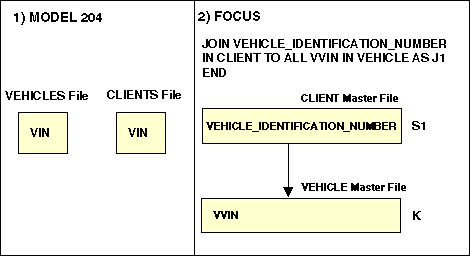
- Are two Model 204 files, VEHICLES and CLIENTS. Each file
contains one logical record type for this example. The common or
key field is VIN.
- Are two equivalent server segments. Each segment is described
in a separate pair of Master and Access Files. The field names for
the common field are VEHICLE_IDENTIFICATION_NUMBER and VVIN. The
Model 204 key fields are specified with the TYPE=KEY attribute in
the Access File.
The JOIN command includes the names of the Master Files and the
common field names. To retrieve data from the joined structure,
issue a report request that specifies the host (or parent) Master
File from the JOIN command.
Note: Since in this example each Model 204 file consists
of one logical record type, record type fields are not specified
in the Access Files.
The following diagram illustrates a Model 204 file with two record
types and the Server Join:
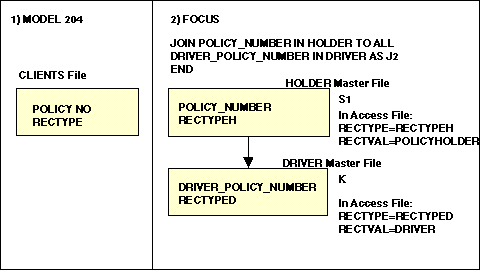
- Is the Model 204 CLIENTS file containing two logical record
types. The common or key field is POLICY NO. The RECTYPE field contains
the value POLICYHOLDER for the HOLDER record type and the value
DRIVER for the DRIVER record type.
- Are two equivalent Master File segments. Each segment is described
in a separate pair of Master and Access Files. The field names for
the common field are POLICY_NUMBER and DRIVER_POLICY_NUMBER. The
Model 204 key fields are specified with the TYPE=KEY attribute in
the Access File. Since both record types reside in the same Model
204 file, each Access File segment declaration also includes RECTYPE
(record type) and RECTVAL (record type value) attributes.
The JOIN command includes the names of the Master Files and the
common field names. To retrieve data from the joined structure,
issue a report request that specifies the host (or parent) Master
File from the JOIN command.
x
You can also implement Join
relationships by describing a multi-segment FOCUS structure in a
single pair of Master and Access Files. If there is a shared or
common field, you can create an Embedded Join for:
- Separate physical Model 204 files that each contain one
logical record type. The Model 204 files are described as segments
in the multi-segment structure.
- Logical record types that originate from the same Model 204
file. These record types are described as segments in the multi-segment
structure. In the Access File, the RECTYPE and RECTVAL attributes
in each segment record identify the record type field and its corresponding
value.
- Other multi-segment FOCUS structures. A Master File might relate
two hierarchical structures as one. For example, the AUTO Master
File might incorporate the VEHICLE and CLIENT Master Files.
Embedded Joins offer two advantages:
- They create a logical FOCUS view of the record types. The
view may also provide a measure of security by limiting access to
segments or fields.
- You do not have to issue an explicit JOIN command.
When you create a Master File, describe the Model 204 logical
record types or files as a hierarchy. Start first by choosing a
record type or file to be the root segment. The root segment has
dependent segments which, in turn, may have dependent segments.
The dependent segments identify the superiors (or parents) with
the PARENT attribute. Any record type can act as a dependent provided
that its shared field is a key field.
In the associated Access File, for each pair of related segments,
specify the shared field from the parent and dependent segments
with the KEYFLD and IXFLD attributes. The Interface implements the
relationship by matching values at run time.
The Embedded Join is executed automatically when you issue a
report request that references fields from two related segments.
You do not specify the shared field in your report request; the
selection of the shared field is transparent.
Note: It is possible to join unrelated Model 204 files
and record types that do not have common fields by describing a
DUMMY segment.
The following diagram illustrates an Embedded Join for two Model
204 files:

- Are two Model 204 files, VEHICLES and CLIENTS. Each file
contains one logical record type for this example. Since they exist
as physically separate files, they do not contain a Model 204 record
type field. The common or key field is VIN.
- Are two equivalent FOCUS segments described in one pair of Master
and Access Files. The field names for the common field are VEHICLE_IDENTIFICATION_NUMBER
and VVIN. The Model 204 key fields are specified with the TYPE=KEY
attribute in the Access File.
To create a parent/child relationship,
describe the HOLDER segment as the parent (or root) and the VEHICLE
segment as the dependent in the Master File. Include the PARENT=HOLDER
attribute in the segment declaration for VEHICLE. In the Access
File, specify the KEYFLD and IXFLD attributes to create the Embedded
Join.
The following diagram illustrates an Embedded Join for a Model
204 file with two record types:
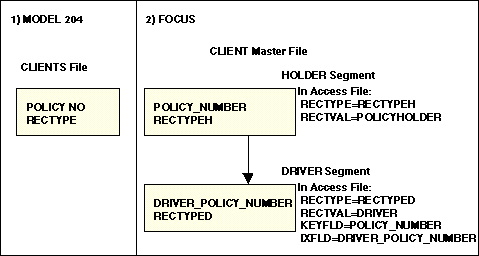
- Is the Model 204 CLIENTS file containing two logical record
types. The common or key field is POLICY NO. The RECTYPE field contains
the value POLICYHOLDER for the HOLDER record type and the value
DRIVER for the DRIVER record type.
- Are two equivalent FOCUS segments described in one pair of Master
and Access Files. The field names for the common field are POLICY_NUMBER
and DRIVER_POLICY_NUMBER. The Model 204 key fields are specified
with the TYPE=KEY attribute in the Access File. Since both record
types reside in the same Model 204 file, the Access File segment
declarations also include the RECTYPE (record type) and RECTVAL
(record type value) attributes.
To create a parent/child relationship,
describe the HOLDER segment as the parent (or root) and the DRIVER
segment as the dependent in the Master File. Include the PARENT=HOLDER
attribute in the segment declaration for DRIVER. In the Access File, specify
the KEYFLD and IXFLD attributes in the DRIVER segment declaration
to create the Embedded Join.
x
You can describe unrelated Model 204 files or logical
record types as Embedded Joins even if a shared field does not exist.
To do so, describe a special dummy segment (SEGNAME=DUMMY) as the
root in the Master File. Then, specify the unrelated segments as
parallel dependents of the dummy root. Since the dummy segment is
a virtual segment, do not describe fields for it in the Master File,
and do not include a corresponding segment declaration for it in
the Access File.
If your report request includes fields from two or more segments,
FOCUS makes only one retrieval pass over the answer set returned
by the Model 204 DBMS. Fields specified for sort phrases (BY and
ACROSS) and screening tests (IF and WHERE) must lie on the same retrieval
path as the other requested fields. You cannot use a field from
one unrelated segment to sort the data in other segments.
The following diagram illustrates two Model 204 files, the CLIENTS
file and the VEHICLES file. These two files are joined using a FOCUS
dummy segment:
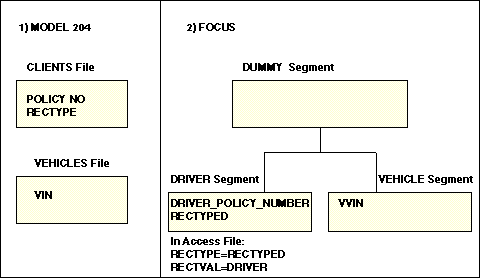
- Are two Model 204 files, CLIENTS and VEHICLES. The record
type field in the DRIVER segment identifies all client records that
have the value 'DRIVER'. A dummy segment is needed because there
is no shared field to cross-reference or join these files.
- Is an equivalent multi-segment FOCUS structure. The root is
a DUMMY segment. The two dependents are related to the root. They
are not related to each other because a common field does not exist.
To create a Master File for this structure, specify the segment
declaration for the dummy segment (SEGNAME=DUMMY) first, so it functions
as the root. Do not describe fields for it. Then, describe the dependent
segments, and include the PARENT=DUMMY attribute to identify the
dummy segment as the parent. In the associated Access File, do not specify
a segment declaration for the dummy segment; include segment declarations
only for the dependent segments. The record type field is required
in the DRIVER segment since the DRIVER segment comes from a Model
204 file, CLIENTS, that contains two logical record types. Do not
specify KEYFLD/IXFLD values.
x
Model 204 and FOCUS use similar elements:
|
Model 204 Entities
|
FOCUS Entities
|
|---|
|
Model 204 field
|
FOCUS field
|
|
Logical record type
|
FOCUS segment
|
|
Individual record
|
Segment instance
|
|
Model 204 file with one record type
|
FOCUS segment
|
|
Multiply-occurring Model 204 fields in a record
|
FOCUS OCCURS segment
|
Some general rules for describing Model
204 files are:
- Each logical record type becomes a FOCUS segment. A FOCUS
segment may represent an entire Model 204 file (with one logical
record type) or one logical record type from a Model 204 file with
several record types.
- A Model 204 file containing two or more logical record types
must have a record type field to identify each record type.
- A Model 204 file containing one logical record type does not
require a record type field; the Model 204 file may contain an optional
one.
- Relationships can be implemented with the JOIN command or by
describing Embedded Joins in the FOCUS file descriptions. The maximum
number of Model 204 files or logical record types that can be related
is 64 for Embedded Joins and 16 for Dynamic Joins.






